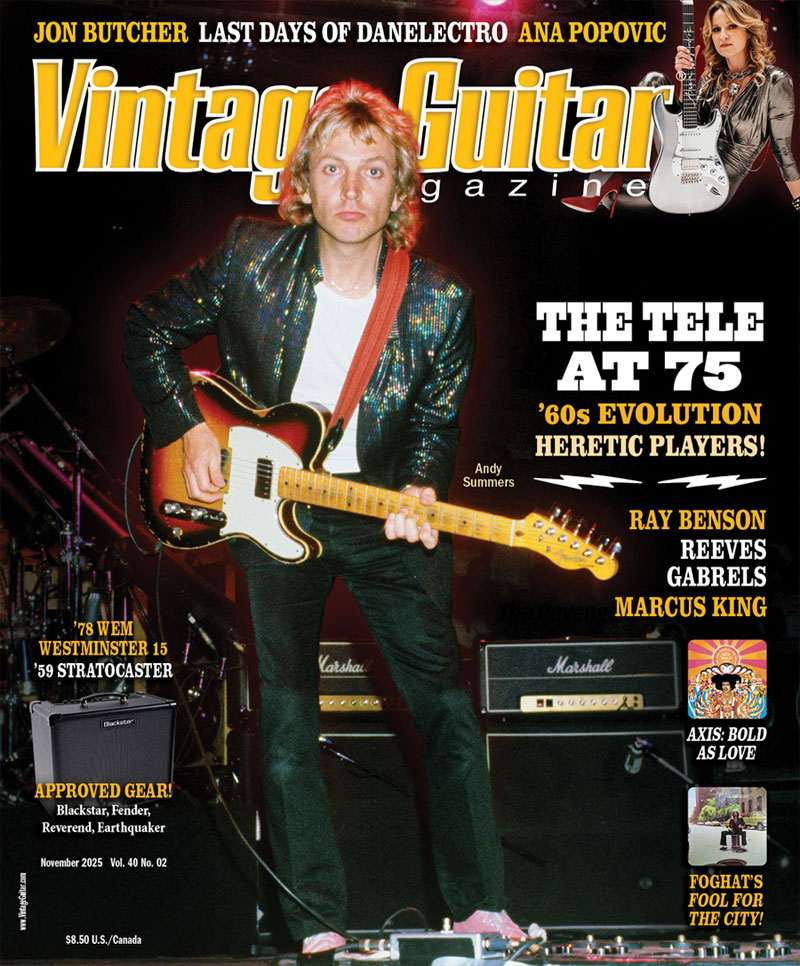
Growing up 10 miles from Earl Scruggs’ birthplace in North Carolina with a music-loving father and two older sisters who could impress on the piano, it makes sense that Harold Wright became a musician. And while he followed in the girls’ footsteps by starting piano lessons when he was 12, after two years, he (and his parents!) realized it wasn’t a good fit.
In 1962, “The Adventures of Ozzie and Harriet” was still popular on TV, and young Harold (who family and friends called “Sonny”) was fully tuned into Ricky Nelson singing while James Burton picked behind him. Toss in Duane Eddy’s “Rebel Rouser” on the radio, along with Scotty Moore backing Elvis and tunes by the Ventures, et al. The guitar was starting to boom. Having sandbagged his way out of piano lessons, “I knew what I wanted to play,” Wright recalls. “After much discussion and begging, my parents agreed to get a guitar for me, but only if I took lessons because they weren’t about to spend their hard-earned money on something I’d throw under the bed and forget about.”
He was happy to oblige, and a few days later, a shiny new Silvertone Model 1415 and 1471 amp arrived, courtesy of Sears mail-order. Sonny readily jumped into lessons, digging everything about it. After six months, the teacher said he was ready to fly on his own, “And I did,” he chuckled. “I was on a roll, and popular with the girls since I was the only 14-year-old boy around who played an instrument of any kind. It was great!”
Submitted for your approval – the idyllic existence of a babyboomer teen. Then along came the Vietnam War.
By 1966, Wright was an 18-year-old facing the draft. Preferring to have a say in his role, that August he enlisted in the U.S. Air Force and was shipped to basic training at Lackland Air Force Base in San Antonio, followed by advanced training as a B-52 mechanic at Chanute AFB in Illinois. After a year at Warner Robins, Georgia, he received ship-out orders to Tan Son Nhut Air Base, Saigon. Given leave before the deployment, he went home to visit friends and family. One day, his dad, Allen, suggested that Sonny take a guitar along on his hitch, and offered to buy one.
“Of course I liked the idea, so I started checking the classifieds,” he said. “A couple days later, I saw an ad for a Gibson J-45 for $100. Dad and I went to see it, and the lady’s five-year-old daughter brought the guitar from a back room, dragging it by a string (laughs). Picking it up, I noticed smudges of peanut butter and jelly on the front but it had been played very little. We settled on $75.”

A couple days later, he was off, J-45 in its chipboard case, latches taped to ensure they’d stay closed, ID tag tied to its handle, set to ride in the belly of a Boeing 707 as they traversed the Pacific Ocean.
Aircraft mechanic in Vietnam was a go-where-needed job, so Wright saw a lot of base-to-base travel, J-45 along at every stop. “If I was going by chopper, I had my duffle slung over my shoulder and the guitar in my hand,” he said. “No pilot or crew chief ever refused to let me carry it onboard. In the barracks, I usually left it on my bunk; sometimes it would disappear for two or three days, but I never worried about it. It’d show up right where I had left it, sometimes with a note from another GI saying, ‘See you back home’ or just ‘Thanks’.”
Wright’s tour ended a year later and he returned home safe and sound. Life returned to normal and he started dating a local girl named Judy Allen. The young couple often sat under an old oak tree in her yard, Harold playing the guitar and singing for her – everything from “Blue Suede Shoes” to “Long Black Veil.”
When a co-worker asked him to show her some chords so she could play for young people on outings for her husband’s church congregation, Wright was more than happy to oblige, and they started spending one lunch hour per week practicing songs. One day, though, someone with bad intent saw him put the guitar in his car.
“I always locked it when we were finished, but when I left work later that day, the guitar was gone,” he said. “Someone had stolen it.”

Every bit as depressed as you’d think, he struggled to grasp why…
“I couldn’t believe it. A guitar that had followed me halfway around the world and brought joy to countless GIs, then serenaded my future wife, was gone forever. The loss was terrible, and I’ve always thought it hurt Dad as much or more than me since he played such a big part in helping me get it.”
He filed a police report, started checking pawn shops, and even wrote a letter to the local newspaper, offering a reward. Nothing turned up.
Several years later, he found another sunburst ’65 J-45 and bought it from the family of its original owner. And while it’s identical in every respect, “I’ve never had the same feeling when I play it,” he said. “Does it bring back memories? Yes; when I look at it, I remember Dad smiling as I played ‘Wildwood Flower,’ ‘Jimmy Brown,’ or his favorite, ‘Little Rosewood Casket’ and him joining in on harmonica. I see all the soldiers playing it and singing songs, and I see Judy smiling at me under that big oak tree, dreaming of our future together.
“Most players have a guitar that’s more like a friend or loved one. The J-45 was that for me; Judy and I have been married 54 years and it was a huge part of our lives.”
On the sunny side, the “replacement” has helped create its own share of memories.
“For sure, it has provided countless hours of happiness to me and my family. It’s been a part of weddings and – sadly – funerals for friends and relatives.
“In a way, each guitar has a life of its own. I’m just glad I was allowed to be part of the lives of two special guitars.”
Special thanks to Susan (Wright) Spencer.
Do you have a collectible/vintage guitar with an interesting personal story that might be a good fit for “Classics?” If so, send an e-mail to ward@vintageguitar.com for details on how it could be featured.
This article originally appeared in VG’s October 2024 issue. All copyrights are by the author and Vintage Guitar magazine. Unauthorized replication or use is strictly prohibited.



